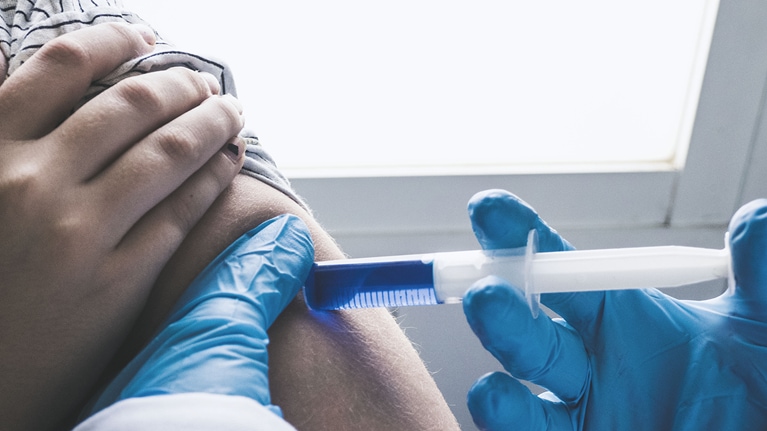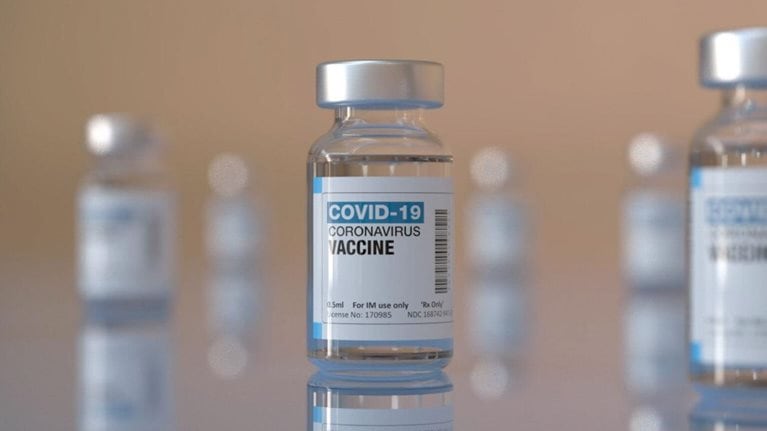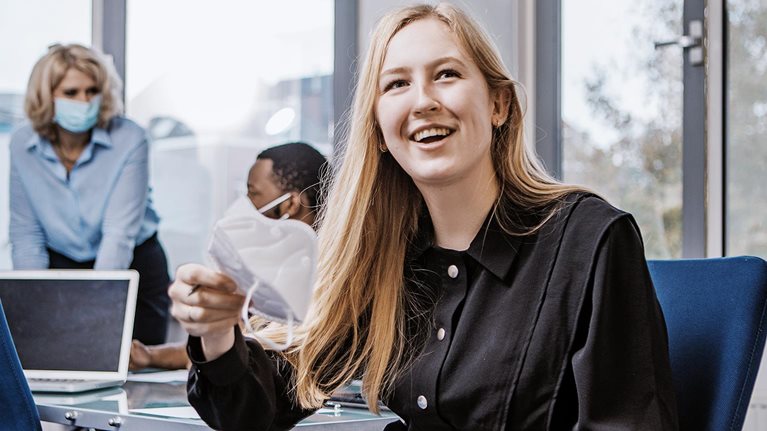More than 63 percent of the US population have received at least one dose of a COVID-19 vaccine, and more than 54 percent have been fully vaccinated, as of September 16, 2021, according to the Centers for Disease Control and Prevention. Approximate thresholds for herd immunity are benchmarked from 80 to 90 percent, which would require a minimum of roughly 80 million additional individuals to be vaccinated in the next few months.1
Despite strong demand for COVID-19 vaccines in early 2021, by the end of May daily administration rates dropped to a third of their mid-April peak, reflecting waning consumer demand.2 While daily administration rates climbed moderately at the end of August, as of September 10, around 567,000 doses were being administered daily, compared with nearly six times that in April.3 At the same time, the United States continues to experience regional outbreaks, in part due to new variants such as Delta.4 As new variants with potentially greater severity and transmissibility continue to emerge, the effectiveness of existing vaccines or strength of immune response against these will be crucial to consider. This concern about emerging variants could potentially underscore the criticality of all eligible persons receiving the vaccine (Exhibit 1).

Many stakeholders are therefore evaluating how to reinvigorate vaccination rates, especially in light of potential federal requirements. Experts have sought to understand consumer decision making for adoption of COVID-19 vaccines. McKinsey consumer research, beginning in the summer of 2020, has understood consumer segments defined by their self-identified plans to receive a COVID-19 vaccine. These include four categories of consumers: ‘Unlikely’ (stated plans not to receive a COVID-19 vaccine), ‘Cautious’ (those who are uncertain whether to receive a COVID-19 vaccine), ‘Interested’ (those who have already scheduled or are planning to schedule their COVID-19 vaccination appointments), and ‘Already vaccinated.’
The COVID-19 vaccination rollout has been unprecedented, with more than 300 million COVID-19 vaccine doses already administered so far in the United States. Some of the unique factors that enabled this effort have been the setup of mass vaccination clinics, the proliferation of drive-through and mobile clinics, and the ability of pharmacies to administer shots. Stakeholders, including state governments, employers, and providers, are already taking meaningful actions to address vaccine hesitancy. In addition to the options detailed in this article, stakeholders may consider making fundamental shifts in their approach as the United States enters this next phase of COVID-19 vaccine rollout:
- Expanded stakeholder engagement in driving adoption with a broader set of incentives. To date, governments have helped lead community vaccination efforts with the support of providers, pharmacies, and other stakeholders. Moving forward, other stakeholders may decide to play an even larger role. This role could include businesses requiring patrons to be vaccinated where warranted, providers and pharmacists engaging in patient discussions regarding the vaccine, and insurers building in value-based care incentives for providers to deliver against vaccine adoption targets, for example. As of September 9, the Biden administration has made vaccination mandatory for federal employees, removing the option for testing weekly.5 The administration has also recommended that the Department of Labor’s Occupational Safety and Health Administration develop a new rule regarding vaccination. This rule could require all employers of more than 100 people to either ensure 100 percent vaccination of their workforce or perform testing on a weekly basis to unvaccinated individuals. This recommendation has yet to play out, but could have a potential impact and lift on adoption of vaccination if enacted as recommended.
- Personalized messaging and targeted engagement to address person-specific needs. Marketing to consumers remains largely broad-based and through more traditional channels. The ability to tailor messages and engagement approaches to consumer segments could have outsized impact in informing consumers. Additionally, data reflects barriers and reservations consumers have to getting the vaccine. Messages can vary. For example, those concerned about safety or side effects value information from trusted sources that speak directly to specific concerns (for example, fertility). Some consumers are focused on the freedom to make their own choice. Others may consider the vaccine if it affects those they care about.
- Agile approach to rapidly test, learn, and adapt approaches quickly. Several vaccine campaigns have been launched, but there may be room for improvement in how quickly these are tried, learned from, and modified. Best-in-class campaigns adjust on a daily basis, learning and adapting in real time to what marketers discover. Agile programs can adapt to the changing environment, learn what works and what doesn’t, leading to greater effectiveness of spend while improving outcomes.
Here, we detail trends among the remaining unvaccinated, and discuss specific actions that could address the drivers of hesitancy within these populations.
Given the minimal movement in ‘Unlikely’ vaccinators over time, we choose to focus on the ‘Cautious’ segment here. Since December 2020, this segment has shrunk from 45 percent to 8 percent of respondents (Exhibit 2). Addressing the questions or concerns of even half of the ‘Cautious’ individuals and moving them to ‘Interested’ and eventually ‘Vaccinated’ status could translate to more than ten million Americans protected against severe COVID-19. A part of the ‘Cautious’ group represents decision makers for minors, and will strongly influence whether their children receive a vaccine. Across the ‘Cautious’ and ‘Unlikely’ groups, an opportunity exists to address potential barriers, including communication from trusted advisers, improved convenience, and the reduction or elimination of direct and indirect costs associated with getting the COVID-19 vaccine.

Would you like to learn more about our Healthcare Systems & Services Practice?
Demand trends
Further enabling decreasing hesitancy among the ‘Cautious’
Certain population segments and demographics are disproportionally represented in the ‘Cautious’ segment. ‘Cautious’ adopters are more likely to identify themselves in our survey as women, to be in a household with less than $25,000 total annual income, and live in a rural area compared with all respondents.
Among the ‘Cautious,’ the most common remaining concerns lie around safety and side effects, with nearly half of these respondents concerned about long-term side effects. Twenty-eight percent of these respondents have indicated that they received the flu shot in the 2020–21 flu season, demonstrating openness to vaccination once their concerns are addressed.
Multiple factors influence the likelihood of receiving a COVID-19 vaccine. As detailed in the article “COVID-19 vaccines meet 100 million uncertain Americans,” a combination of at least three highly interrelated conditions is required for broad adoption: “conviction” (desire to receive the vaccine), “convenience” (ability to access end-to-end vaccine processes without hassle), and “costlessness” (ability to take time away from work in order to get the vaccine).
Examining respondents in May who identified as ‘Cautious’ but received the vaccine later can offer clarity on motivation
The top reasons these respondents waited before becoming vaccinated was to see how it impacted other people before getting it themselves (17 percent), difficulty getting an appointment (15 percent), and concern about long-term side effects (14 percent) (Exhibit 3). Correspondingly, ability for walk-in appointments and ability to pick the brand of vaccine they received were identified among the top influencers that resonated with them to receive a vaccine. Further, when asked why they ultimately chose to get the vaccine, the top reasons included that they thought it was the right or responsible thing to do (12 percent), it would protect them (13 percent), or that they ultimately didn’t want to risk getting COVID-19 (13 percent).

Considering the ‘Unlikely’
In contrast with the ‘Cautious,’ survey respondents in the ‘Unlikely’ segment have shown minimal movement over the past eight months, remaining relatively steady at about 15 percent of respondents. This group has historically indicated hesitancy toward vaccination in general. Only 14 percent indicated that they received a flu vaccine in the 2020–21 flu season, and just 11 percent intend to get one for the upcoming 2021–22 flu season. Nonetheless, they indicated some interest in receiving a COVID-19 vaccine with incentives, particularly cash rewards or raffles for cash prizes (13 percent and 9 percent responding positively, respectively).
Attitudes of the unvaccinated are further complicating vaccination efforts. The unvaccinated have indicated pressure to get vaccinated has either little or an opposite effect on their willingness to do so. Almost a quarter (24 percent) of ‘Unlikely’ respondents state that they are less likely to get the COVID-19 vaccine because they do not like being told what to do. The ‘Unlikely’ are more extreme in this view than the ‘Cautious’ or ‘Interested.’ The unvaccinated also deny that their actions are contributing to the rise and spread of Delta, with only 8 percent of the ‘Unlikely’ agreeing with the statement that “The current spread of COVID-19 is being caused primarily from the people who won’t get vaccinated.”
If this population continues to remain unlikely to receive a COVID-19 vaccine, a higher burden will exist to vaccinate nearly all or most ‘Cautious’ and ‘Interested’ respondents to reach herd immunity. Likewise, because conviction-driven hesitancy may be difficult to address, stakeholders may want to focus on achieving full or near-full adoption of populations with cost or convenience-based constraints. This concern is especially becoming critical as infections and deaths remain disproportionately high among the unvaccinated, with more than 99 percent of COVID-19-related deaths in June 2021 occurring among unvaccinated individuals.6 While there is an increased incidence of breakthrough infections with the Delta variant, the rate of infection and hospitalization for the vaccinated is respectively at one in 5,000 and one in a million per day.7
Addressing hesitancy in decision makers for minors
The big question on the mind of vaccinated parents is: How do I decide whether and when to vaccinate my children for COVID-19? In May 2021, the FDA authorized the use of the Pfizer/BioNTech vaccine in adolescents aged 12–15 years.8 At the time of this article, most states require parental consent to receive COVID-19 vaccination for children under the age of 18. Parents and guardians are critical decision makers who will influence rates of vaccination among adolescent and pediatric populations.
Parents who expressed hesitancy about vaccinating their children largely align with those who have concerns about receiving the vaccine themselves. Sixty-six percent of respondents who already received their vaccine are planning to vaccinate their children, compared with 9 percent of respondents in the ‘Unlikely’ segment. Around 45 percent of parents with children under age four said they planned to have them vaccinated once doses are approved for that age group and are available; this number climbs to around 53 percent when looking at children of all ages.
Approximately 20 percent of parents or guardians with children in the household said they are not likely to vaccinate their children. The primary reasons for this decision given by parents or guardians included a concern about potential vaccine long-term side effects (31 percent), a feeling that the development was too rushed (19 percent), that the vaccine is unproven (21 percent), that side effects could be serious (21 percent), and concern about ingredients (15 percent). Therefore, engaging parents and guardians in a meaningful way could have outsized impact on overall vaccination rates.

How COVID-19 has changed the way US consumers think about healthcare
Actions for stakeholders to consider
Addressing barriers to adoption will require joint mobilization across public and private stakeholders. States, healthcare providers, payers, pharmacies, and employers may each be positioned to take different approaches, but together can take actions that matter to consumers to increase the likelihood of receiving the vaccine.
Conviction
Many consumers either are unmotivated to get the vaccine or have unaddressed concerns. For example, some would rather take the risk of getting COVID-19 (17 percent), do not like needles (10 percent), or assume that they would only get mild symptoms from COVID-19 if they were to become infected (4 percent) (Exhibit 4).

- Choice of vaccine brand was the highest reported driver of increased likelihood to receive the vaccine among the ‘Cautious’ and ‘Unlikely’ groups, with 32 percent ‘Cautious’ and nearly 8 percent ‘Unlikely’ saying that brand choice would increase their likelihood to receive the vaccine. States may want to consider allowing consumers the choice of vaccine when they schedule appointments, or help them find locations that offer their vaccine preference.
- Providers can lean on their existing relationships and trust with patients to engage in a meaningful fact-based dialogue in order to address concerns or unanswered questions, thereby increasing conviction. A large portion (27 percent) of the ‘Cautious’ look to their physician for information regarding the COVID-19 vaccine. Pediatricians play a particularly important role in influencing likelihood of vaccination with parents of adolescents and children. Most parents in the ‘Cautious’ and ‘Unlikely’ groups have said they would prefer their children to be vaccinated at a hospital or doctor’s office.
This preference may be due to higher levels of comfort and trust fostered over the length of the physician-patient relationship, which would potentially allow individuals anxious about receiving the vaccine to get their questions answered in a more relaxed setting, rather than at large vaccination sites.
However, it is important for physicians to leverage this trust to provide recommendations that can influence the ‘Cautious’ and ‘Unlikely.’ Currently, many healthcare providers are not doing so, with 22 percent providing no recommendation about the COVID-19 vaccine, and more than 11 percent advising patients against receiving the vaccine.
Additionally, pediatricians are the most preferred source of advice for deciding whether to vaccinate their children. However, this finding decreases from 20 percent overall to only 8 percent for the ‘Unlikely’ parents or guardians, indicating a widening chasm in the level of trust toward physicians within this population. - Healthcare provider sites that already offer the vaccine may consider various approaches to building trust with new and existing patients. For example, providers may engage in novel approaches to share information with patients, such as holding virtual ‘office hours,’ and leveraging digital tools and communication materials in order to answer patients’ questions. Physicians may also consider building upon vaccine services (for example, being able to schedule appointments directly with the doctor, getting follow-ups post-vaccination), which ‘Cautious’ respondents noted would increase their likelihood to receive the vaccine.
Convenience
Many consumers cited hurdles, including concerns about missing work due to vaccine side effects, lack of transportation, not wanting to wait in line for the vaccine, or finding it difficult to make an appointment. Addressing these issues can help provide vaccine access to those in the ‘Cautious’ and ‘Unlikely’ groups who see value in getting the vaccine but are unable or unlikely to do so at the moment.
- Walk-in opportunities and appointment scheduling assistance may address some needs. Among initiatives targeting convenience, 24 percent of ‘Cautious’ and 8 percent of ‘Unlikely’ respondents report that having available walk-in appointments would increase their likelihood to be vaccinated, and a similar proportion would respond positively to the ability to schedule a vaccine appointment by phone.
- Employers and school systems can each separately help increase access to vaccines by setting up on-site clinics, conducting drives, and encouraging family vaccination days. Survey respondents reacted positively to such tactics. Twenty-four percent of ‘Cautious’ and 9 percent of ‘Unlikely’ individuals said vaccination at their doorstep would make them more likely to get the vaccine, while a similar percentage said they would be more likely to get the vaccine if they had vaccination sites they could easily access or were able to schedule a family appointment. Mobile clinics may help address these needs and expand access to those with difficulties traveling to vaccination sites. Around 21 percent of ‘Cautious’ and 10 percent of ‘Unlikely’ respondents said they would be more likely to get the vaccine if they had the ability to do so at their workplace.
- Another potential cause of inconvenience is travel to and from vaccination sites. States and cities may consider alleviating some of this inconvenience by arranging mobile clinics or temporary vaccination sites near rural health providers or grocery stores. Some cities, such as Philadelphia, have offered community shuttles and rideshares for individuals or groups trying to access vaccination sites. North Carolina is offering cash cards to individuals who help drive others to vaccine sites.
Costlessness
Further, some respondents indicated hesitation about getting the vaccine due to cost considerations (for example, not knowing whether they would be able to afford the vaccine) and several said they would be more likely to get the vaccine if their employer were to offer time off to get the vaccine or cope with the side effects.
- Employers may have an opportunity to support their employees in the next phase of vaccine uptake, as discussed in “Getting to work: Employers’ role in COVID-19 vaccination.” Twenty-five percent of ‘Cautious’ respondents said they would have increased likelihood of getting vaccinated if their employers offered compensation (such as a cash reward).
- Employers may also consider paid time off or flexibility in order to receive the vaccine and recover from any potential side effects. For example, retailers such as Trader Joe’s and Target9 are offering hourly employees two hours of pay per vaccine dose taken, and companies such as Lidl10 are offering a payment of $200 per employee in order to cover any costs associated with vaccine administration. These costs include travel and childcare.
- States may consider incentives in cash or in kind in order to encourage vaccination. States like North Carolina11 have provided various incentives, such as cash cards, to those receiving first doses, and other states such as West Virginia, Minnesota, and New York12 are offering various prizes, including hunting or fishing licenses, state park passes, scholarships, and vacations.
Stakeholder enablement
These actions may not directly engage consumers, but can improve consumer conviction, convenience, or costlessness indirectly.
- Respondents who are covered under Medicaid indicated they are unvaccinated in greater proportions than other groups, with 50 percent unvaccinated compared with 29 percent unvaccinated overall.13 Medicaid providers have direct access to their patients and information about them and are thus well positioned to enact interventions. For example, managed care organizations can contact patients who may benefit from vaccination and share information regarding the vaccine.
- Payers could consider higher reimbursement rates for vaccination. The Centers for Medicare & Medicaid Services announced an increase in the Medicare payment amount to approximately $80, from $45, for the administration of vaccines requiring two doses, and $40, from $28, for the administration of vaccines requiring one dose each.14
- Payers may also use their networks to facilitate vaccine education among member populations and partner with nongovernmental organizations and health systems to expand their reach. The Blue Cross Blue Shield Association is one such example, collaborating with Feeding America® to access a population of 40 million through their network of food banks and share materials on topics related to the COVID-19 vaccine.15
- Federal and state governments can help normalize COVID-19 vaccination and lower barriers to access by integrating this information into the routine well-child workflows, similar to other pediatric vaccinations. An example of this routinization is the inclusion of mental health screenings in primary care settings, which led to improved quality of life for patients and lowered costs, among other benefits.16
As the United States plans to prepare for an uncertain winter, many residents wonder what’s next, and how to keep themselves and their families safe. Effective stakeholder actions to boost COVID-19 vaccination rates addressing the ‘Cautious’ and ‘Unlikely’ could help protect millions against COVID-19. Even as many return to in-person work and activities, the lack of ability for children to be vaccinated, and the issues facing ‘Cautious’ and ‘Unlikely’ vaccine adopters, coupled with the urgency created by emerging variants of concern, should remind policy, business, and healthcare stakeholders that several hurdles remain to reach potential herd immunity levels. By considering joint mobilization of public and private sector entities to address vaccine accessibility concerns, the United States can protect more of its residents from infection and help reduce deaths due to COVID-19.


